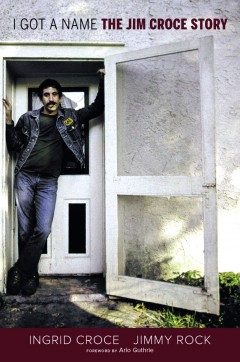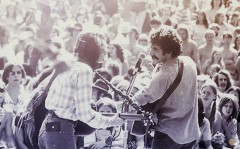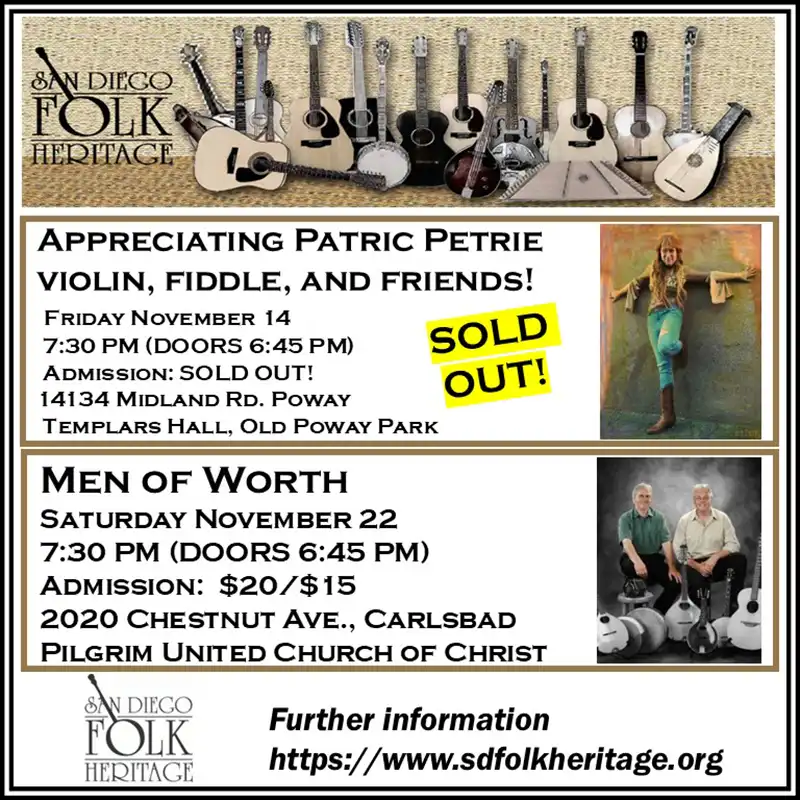Yesterday And Today
A Conversation with Ingrid Croce and Jimmy Rock

Ingrid Croce and husband, Jimmy Rock. Photo: Jay Warren.

I Got a Name book cover

Jim, Ingrid, and A.J. Croce, 1972.

Croce & partner Maury Muehleisen playing to a crowd, ca. 1972

Croce’s restaurant today, in downtown San Diego
It’s likely that no musician is more identified with San Diego than the late Jim Croce. His face and surname are among the most visible images in downtown San Diego, thanks to his wife, Ingrid Croce, for her restaurant and her tireless dedication to preserving Jim Croce’s legacy. Meanwhile, the music of Jim Croce is as popular as ever, showing up in southwarks and commercials as well as remaining a radio staple nearly 40 years after his passing. It’s a testament to his enduring popularity that while only five albums (the second with Ingrid as his musical partner) were recorded during his lifetime, 19 compilations and live discs have been released since 1973.
Sitting in Ingrid Croce’s downtown office, one is surrounded by a whirlwind of activity. Overseeing the restaurant, as well as the neighboring Jazz Bar and running the Croce Music Group, would be daunting enough for most people but Croce is also a respected author, having penned several cookbooks and a song anthology. Her most recent effort, a biography, I Got a Name: The Jim Croce Story, is a collaboration with her husband, Jimmy Rock.
There have been several San Diego-area signings, with a national book tour starting in Philadelphia next month that will take Croce and Rock through the East Coast and Midwest before finishing up with a West Coast jaunt.
In the nearly four decades since Jim Croce died in a plane crash at the age of 30, Ingrid Croce has appeared in various television programs, discussing events, and has written several books that touch on stories behind songs and family, but I Got a Name greatly expounds on all that, filling in the blanks with no holding back on less positive details of the story. From young folk singers to worldwide fame, it’s all there.
The book has had a long road to the publisher, with four years of work put into the current version, but research and a first draft was begun back in the early nineties. Why now for the completed book?
Croce explains the timing is finally right. She cites a dark episode when she was raped early in her marriage as being a catalyst for things to come, though it would take some time for that realization. “It’s a couple of things,” Croce said. “Number one, I really didn’t understand the story. When we spent four years in writing, I really didn’t understand how my rape, when I was newly married, had affected our relationship,” Croce said. “I knew that it affected it, but I really didn’t really recognize the extraordinary impact that it had, the anger that Jim had and the passiveness that I felt as a result of his anger; I felt responsible, even though I knew I wasn’t. The guilt and the interplay between people who love each other. Rape is an aggressive act and Jim felt perhaps also responsible [in] that he wasn’t there. There were so many things that occurred as a result of that happening that I wasn’t really aware of. So, I think that because I’ve been involved with the Rape Crisis Center at the Center for Community Solutions, and working with people who have had that kind of experience, it brought me a bigger picture of what had really happened to us [and] I was able to then translate that into our own story,” she said.
Croce also cites a chance meeting with longtime family friend, journalist, and musician David Klement as key to the book’s progress. “We mentioned to him, ‘Would you mind reading a book that we’re thinking of putting out?’ and he did. He came back to us with a suggestion that we put my voice in the book and so that’s how we started to revamp it,” she said. It is Klement who did the book’s final edit.
Indeed, the inclusion of Ingrid’s viewpoint is one of the things that makes the book so compelling.
According to Croce it was difficult going over the details of her life. “My greatest concern is not sharing my story, but sharing his story,” Croce remarked. “Jim [Rock] and I were both very cautious. It was painful; it was a painful story. We were both very cautious because we didn’t want to paint Jim in any way but as the hero. It was really, really important to us that people who love Jim’s music still see him as the hero. So, there was a very fine line to walk, because there are times when all of us are embarrassed by how we act. You want to make sure that you’re fair, and Jim was a very private man. So, we used Jim’s brother Rich’s judgment on whether we were overstepping any bounds.”
“We really wanted to understand the story. Because Jim died, you’ve got the beginning, you’ve got the middle, and you’ve got the end. So, you really do get the hero’s journey in the sense that you understand where that journey started. You understand how, at a certain point it came to a crescendo, and then how it came to the end. People already know before they read the book that they’ll have an end.”
Croce notes that the piecing the book together was a lengthy process both in writing and gathering information and photos, etc. “Everything takes time,” she mused. “I was in litigation for 12 years with three different battles; over Jim’s estate, a wrongful death suit, and the airplane crash, so I learned how to save everything because if you don’t have evidence, than you’re screwed,” she said. She points out that having relocated to San Diego just prior to Jim Croce’s death, she was separated from friends and family on the East Coast. “I was here very much alone with A.J., and I had to start all over again. I had to start my new life. I needed to remember things, I needed to have those memories be very strong and I didn’t let them go until I would sit down with someone and tell the story, which is why I got Jim (Rock) involved.
At least part of the wait in the publishing of I Got a Name comes from trying to find the right people to work with. “I’d sit down with someone who wanted to do a movie, for instance, and tell them the story and they’d come back with something that had nothing to do with what I’d told them. (A) publisher said that they wanted me to work with a ghost writer, so I worked with [one] and when he came back and wrote down things that never happened. Jim [Rock] saw my frustration.”
Rock concurs. “I sat through every one of those sessions, so I knew the story pretty well by that point. That’s when she turned to me and said, ‘Help me write this story.’ I was pretty leery in the beginning, but then after getting into it, it was a great experience. It took us four years to gather everything, do the interviews and the writing. We had a publisher, but the publisher said, ‘I want more scandal.’ We said that’s not what it’s about. It’s a story; it seems like there’s enough. We had made the commitment when we were writing it that we were going to tell the [definitive] story because of those experiences of telling the story and getting something else back [from collaborators]. So we said no, gave the advance back, and then we sat on the story for years.”
It’s long been noted that Jim Croce’s life would make the perfect subject for a movie, but to date his only portrayal on screen has been a brief 2009 cameo in ABC-TV’s sci-fi drama “Life on Mars.” There has been significant interest, with actors Paul Michael Glaser, Mandy Patinkin, Andy Garcia, and Edward James Olmos among those vetted to portray the singer over the years. [The movie production house) Castle Rock had the option two or three times, with Andy Garcia attached, but he got too old for the project,” Rock noted. Both Glaser and Olmos made the trek to San Diego, spending time at Croce’s soaking up the vibes.
Ingrid considers the age of the actors in any cinematic portrayal to be crucial to any future project. “If anyone was to say to me [that] so and so should play the part, they’d have to remember that I was 16 to 26 (during those years),” she said. “So we need to find a very young person to play [my] part as well as Jim’s. We’ve got to show that these were young people. This was the late sixties and early seventies and the times were just as important. We were much older then, we’re younger than that now [laughs]. It’s a very different place [today] than we were [in] back then.”
Both Croce and Rock are particularly pleased with I Got a Name’s reception from family members. Perhaps no one knew Jim Croce better than his brother Rich, who has given a whole-hearted seal of approval. “He’s read it three times already. He said, ‘I’ve read it and I feel I know myself better,’” Ingrid stated. “That’s the person, after Jim’s mom passed away, that we cared about most because we didn’t want to harm that relationship between them,” she commented.
Ingrid no longer sings, due to a throat operation, but she’s happy to be creative in other fields. “I miss singing a lot, but I have to take pleasure in what I can do,” she said. Though she has been an artist her whole life, her first solo art show will take place on September 6 – 9 at an Art San Diego Showcase in Balboa Park. Additional plans include a new cookbook in the near future.
One of the most popular Jim Croce items in recent years has been a pair of signature guitars from Martin and Epiphone. They clearly show how far the legend of Jim Croce has come. The Martin D-21 in particular has become highly collectable, with instruments selling for as much as $8,500. “Paul Wilson took the photos of Jim playing that Martin D-21,” Rock explained. “He’s a close friend. In fact, he took the photographs that are on the front and back cover of the book.” Jim Croce had his guitar destroyed and he was sitting with Paul, having to go on the road with an imminent tour, and he was lamenting the fact that he didn’t have a guitar. “Paul said, if you want to borrow my Martin, you can. So Jim took that, and he had the photos taken with him playing that and then he eventually returned it. Years later, Dick Boak who is the guy at Martin who does re-issues of guitars, was talking to Paul Wilson about that guitar. He said, ‘Do you have any idea where that guitar is?’ and Paul said, ‘Yeah, I’m looking at it.” Wilson soon turned over the guitar to Martin. “It turns out that they didn’t make that model anymore and when they got to remaking the model, they found out that the one had that Jim Played, the headstock was all rounded because the molds were so old; they weren’t perfect. And they debated about whether we make it like this or do we make it the way it was supposed to be? So they made it like it was, with an old rounded head stock on it. They were very authentic.”
Limited to 146 of 150 copies available to the public, 73 in Brazilian Rosewood and 73 in Indian Rosewood, Rock notes a nifty extra touch on the guitars. “One of the luthier’s moms was a dime collector and she had 73 uncirculated 1973 dimes, so they put them in the fret board for “Operator,” he said. Ingrid likes to say, ‘This is a guitar that Jim Croce could never afford,’” Rock quipped.
I GOT A NAME: THE JIM CROCE STORY/BOOK REVIEW
Many music fans are aware of the basics in the story of Jim Croce; he passed away in an airplane crash on September 20, 1973, leaving behind an incredible string of hits, including such classics as “Time in a Bottle” and “Bad Bad Leroy Brown.” He is also the father of A.J. Croce.
But the full story of his life has never been told, until now, in I Got a Name: The Jim Croce Story.
It’s ironic that the title of this biography of such a famed singer-songwriter is taken from one of his hit songs — which he didn’t write — but Croce aficionados or anyone who enjoys music biographies are in for a serious treat with this book. It does much more than let the reader know the stories and characters behind the songs. Its 296 pages are revelatory.
I Got a Name is a gripping read, telling the story of both Jim and Ingrid Croce. Indeed, the story is as much about Ingrid as it is about Jim — with no sugar coating and vivid language. It’s a love story, with all the ups and downs that might be expected when one of the couple is perennially on the road. It’s also the story of two artists. There is sadness and joy in the book, as well as some sex and violence, though nothing gratuitous. The story is well told.
Croce and husband Jimmy Rock excel at painting pictures; the book starts off with the end of the story, before heading back a decade to 1963. Reading their words you really feel like you are a fly on the wall. Whether it’s at ill-fated business meetings or family gatherings, you come to know and appreciate the players in the story and the scenery it takes place in. The interludes with Croce’s then disapproving parents are particularly riveting and full of emotion.
The book works on another level as well. I Got a Name should be required reading for anyone signing contracts with a label, clearly showing the troubles that can accompany these decisions. In addition, it also aptly describes the pressures that a life of touring can have on both the musician and his family.
There is an epilogue, but the story basically wraps up with the immediate aftermath of that fateful night, with the last two pages in particular guaranteed to hit the heartstrings. It’s also nice to read the passages that feature San Diego and Ocean Beach. Anyone who was around in the seventies can attest to the images that are evoked.
Bottom line: I Got a Name comes highly recommended, full of new info, great anecdotes, and the reasons why. It’s a definitive look at one of the greatest songwriters of the era.








